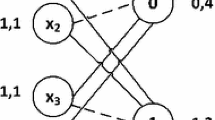Abstract
In this work, we show how cardinality-related information for the set partitioning problem is represented within the simplex tableau and how a fractional solution can be interpreted in terms of unresolved solution cardinality. We include a cardinality row within the linear programming relaxation of the set partitioning problem to demonstrate the associated cardinality-related information present in the tableau. Working with a basic feasible solution, the cardinality row is shown to provide valuable information for branching along the cardinality dimension of the solution space of the problem. It is shown that cardinality information may be derived from the simplex tableau for any subset of structural variables in the problem. An illustrative example and computational results for problems from the literature are presented.
Access this chapter
Tax calculation will be finalised at checkout
Purchases are for personal use only
Preview
Unable to display preview. Download preview PDF.
Similar content being viewed by others
References
Azevedo, F., 2003. Constraint Solving over Multi-valued Logics: Application to Digital Circuits. IOS Press. Berlin.
Bienstock, D., 1996. Computational study of a family of mixed-integer quadratic programming problems. Mathematical Programming 74, 121–140.
Cao, B., and Glover, F., 1997. Tabu search and ejection chains — application to a node weighted version of the cardinality-constrained TSP. Management Science 43(7), 908–913.
Chang, T-J., Meade, N., Beasley, J.E., and Sharaiha, Y.M., 2000. Heuristics for cardinality constrained portfolio optimization. Computers and Operations Research 27(13), 1271–1302.
Fages, F., and Lal, A., 2006. A constraint programming approach to cutest problems. Computers and Operations Research 33(10), 2852–2865.
Garey, M.R., and Johnson, D.S., 1979. Computers and Intractability: A Guide to the Theory of NP-completeness. W.H. Freeman and Company, San Francisco.
Garfinkel, R.S., and Nemhauser, G.L., 1969. The set-partitioning problem: set covering with equality constraints. Operations Research 17, 848–856.
Gomory, R., 1958. Outline of an algorithm for integer solutions to linear programs. Bulletin of the American Mathematical Society 64,275–278.
Gouveia, L., and Martins, P., 2005. The capacitated minimum spanning tree problem; revisiting hop-indexed formulations. Computers and Operations Research 32(9), 2435–2452.
Hoffman, K., and Padberg M., 1993. Solving airline crew scheduling problems by branch-and-cut. Management Science, 39, 657–682.
Joseph, A., 2002. A concurrent processing framework for the set partitioning problem, Computers and Operations Research, 29, 1375–1391.
Joseph, A., and Baker, E.K., 2006. Parametric cardinality probing in set partitioning problems. Forthcoming in Perspectives in Operations Research: Papers in Honor of Saul Gass’s 80th Birthday, Editors: Frank Alt, Michael Fu, and Bruce Golden.
Marsten, R.E., 1974. An algorithm for large set partitioning problems. Management Science 20, 774–787.
Patterson, R., and Rolland, E., 2003. The cardinality constrained covering traveling salesman problem. Computers and Operations Research 30(1), 97–116.
Pierce,. J. F., 1968. Application of combinatorial to a class of all zero-one integer programming problems. Management Science 15, 191–209.
Pierce, J.F., and Lasky, J.S., 1973. Improved combinatorial programming algorithms for a class of all zero-one integer programming problems. Management Science 18, 528–543.
Regin, J., 2001. Minimization of the number of breaks in sports scheduling problems using constraint programming. In Constraint Programming and Large Scale Optimization. DIMACS 57, 115–130.
Rubin, D., 1974. Vertex generation and cardinality constrained linear programs. Operations Research 23(3), 555–565.
Smith, B.N., Layfield, C.J., and Wren, A., 2001. A constraint pre-processor for a bus driver scheduling system. In Constraint Programming and Large Scale Optimization. DIMACS 57, 131–148.
Zabatta, F., 2001. Multithreaded constraint programming: a hybrid approach. In Constraint Programming and Large Scale Optimization. DSMACS 57, 41–64.
Author information
Authors and Affiliations
Editor information
Editors and Affiliations
Rights and permissions
Copyright information
© 2007 Springer Science+Business Media, LLC
About this chapter
Cite this chapter
Joseph, A., Baker, E.K. (2007). Cardinality and the Simplex Tableau for the Set Partitioning Problem. In: Baker, E.K., Joseph, A., Mehrotra, A., Trick, M.A. (eds) Extending the Horizons: Advances in Computing, Optimization, and Decision Technologies. Operations Research/Computer Science Interfaces Series, vol 37. Springer, Boston, MA. https://doi.org/10.1007/978-0-387-48793-9_4
Download citation
DOI: https://doi.org/10.1007/978-0-387-48793-9_4
Publisher Name: Springer, Boston, MA
Print ISBN: 978-0-387-48790-8
Online ISBN: 978-0-387-48793-9
eBook Packages: Mathematics and StatisticsMathematics and Statistics (R0)




